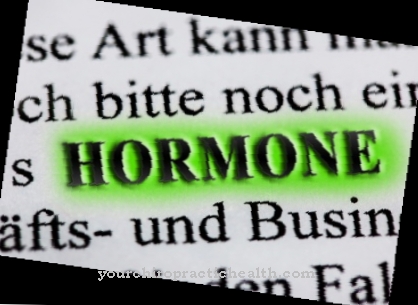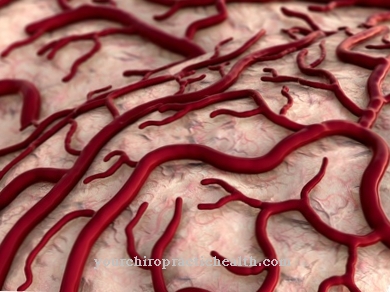With the term Spermatogenesis is called sperm formation. It begins at the onset of puberty and is a prerequisite for reproduction.
What is spermatogenesis?

The male germ cells are formed during spermatogenesis. These are known as sperm. Spermatogenesis takes place in the sexually mature testicles. Here the sperm cells go through various stages of development and finally mature into sperm.
Spermatogenesis lasts an average of 64 days and is controlled by the pituitary and hypothalamus. Disturbances in spermatogenesis can affect male fertility.
Function & task
Even before birth, spermatogonia form from the stem cells of the testicle. This production cycle continues through puberty. Spermatogonia are primordial sperm cells. They arise from the primordial germ cells when they have migrated into the testicular anus of the unborn while still in the womb.
The spermatogonia arise through mitotic cell division of these primary sex cells. The primordial sex cells, also called gonocytes, are located in the seminiferous tubules. During division, type A spermatogonia develop. A further division results in type B spermatogonia from type A spermatogonia. One of these daughter cells remains with the original spermatogonia. This ensures that spermatocytes can be reproduced throughout life.
The B spermatogonia are connected to one another by processes and form groups. The groups go through the different stages of spermatogenesis together. They migrate through the so-called blood-testicular barrier in the direction of the testicular tubules. The blood-testicle barrier lies in the seminiferous tubules of the testicle. It is impermeable to large proteins and immune cells. This differentiation is important because spermatocytes have antigenic properties. This means that they might be fended off by your own immune system.
As soon as the B spermatogonia have arrived in the testicular tubules, they are referred to as first-order spermatocytes. In the testicular tubules they go through the first meiotic division. During this meiosis, second order spermatocytes are formed through haploidization. These are also called secondary spermatocytes.
The first meiosis is followed directly by the second meiosis. Meiosis II produces two spermatids. Spermatids are the smallest cells of the germinal epithelium. They are significantly smaller than the spermatocytes. In the course of spermatogenesis, four spermatids have developed from one spermatocyte.
In the last step of spermatogenesis, in spermiogenesis, these spermatids mature into sperm. The core of the spermatids condenses and there is also a loss of cell plasma. The spermatids also form the typical tail. This is also called Kinozilie. Furthermore, the acrosome arises from the Golgi region during spermiogenesis. The acrosome is the head cap of the sperm. It covers the head and is used to penetrate the egg cell. In spermatogenesis and spermatogenesis, four sperm cells arise from one spermatogonium. Two of them have an X chromosome and two have a Y chromosome.
The entire process of spermatogenesis takes 64 days. The first multiplication of the spermatogonia takes 16 days. Meiosis I covers a period of 24 days and meiosis II a period of just a few hours. The maturation of sperm cells during spermiogenesis lasts 24 days. At the end of spermatogenesis, there is the sperm, which is used to fertilize the female egg.
Illnesses & ailments
Spermatogenesis disorders can have different causes. Natural fertility decreases with age. The sperm cell density decreases from around the age of 40. The spermatozoa are then no longer as mobile. Errors occur more and more frequently during the maturation process. Thus, the number of abnormal spermatozoa increases. Chromosomal changes can also be observed more frequently.
Spermatogenesis can also be disturbed due to genetic abnormalities. If there are no sperm cells in the ejaculate, this is known as azoospermia. Azoospermia is a typical symptom of Klinefelter's syndrome. It is an abnormality that leads to hypofunction of the gonads.
Klinefelter syndrome is hypergonadotropic hypogonadism. If the disorder is at the level of the pituitary gland or the hypothalamus, then it is a question of hypogonadotropic hypogonadism. Typical diseases are the Kallmann syndrome or the pituitary adenoma. Damage to the anterior pituitary gland in hemochromatosis can also affect spermatogenesis and thus impair the formation of sperm.
The spermatogenesis and thus the quality of the sperm is also determined by one's own everyday behavior. For example, malnutrition can lead to a decrease in the amount of sperm. A diet that is not wholesome and low in vital substances with many saturated fatty acids, sweets, ready meals and breaded dishes not only leads to a micronutrient deficiency, but also to restricted spermatogenesis.
The same applies to the regular consumption of alcohol, coffee and tobacco.
Alcohol consumption in particular has a negative effect on sperm development. Due to alcohol-related liver damage, sex hormones can no longer be completely broken down in the organism. This leads to hormonal imbalances at the hypothalamic-pituitary level. The quality of the sperm cells deteriorates and the sperm cell density decreases. In return, the proportion of malformed sperm cells increases.
Smoking restricts the mobility of the sperm cells. In addition, the DNA of smokers is less stable than the DNA of non-smokers. X-rays, ionizing radiation, heat, various drugs and environmental toxins also damage spermatogenesis.
Since spermatogenesis takes place in the testes, diseases of the testicle can also hinder the production of semen. Underdevelopment of the testicular tissue, testicular injuries, infection of the prostate, undescended testicles or a mumps-related testicular inflammation can reduce the quality and quantity of sperm.












.jpg)



.jpg)










.jpg)
